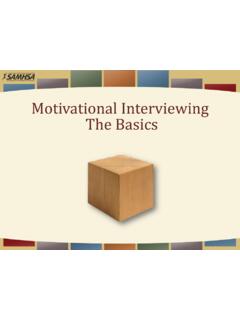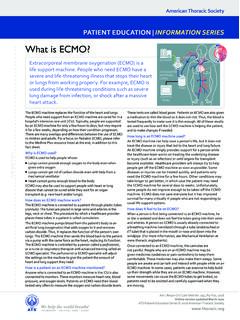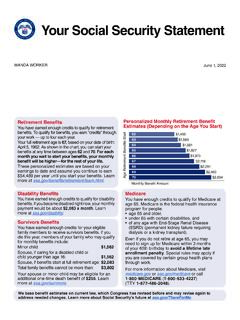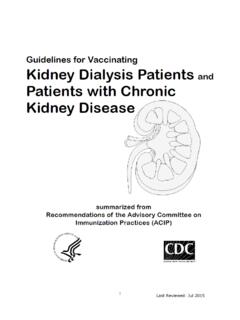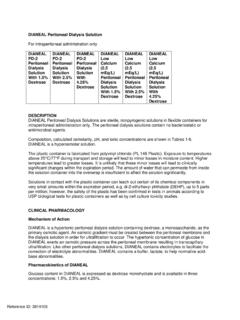Transcription of VTE Prophylaxis - Rush University
1 Anticoagulation Dosing Guideline for Adult COVID-19 Patients Enoxaparin is the preferred first line anticoagulant for patients diagnosed with COVID-19. The incidence of HIT with enoxaparin is less than 1%. VTE Prophylaxis : VTE Prophylaxis will be considered for COVID-19 patients who are low risk. Low risk COVID-19 patient 1. Not receiving mechanical ventilation 2. D-Dimer < 6 mg/L 3. ESRD on iHD without clotting Kidney Function BMI (kg/m2) Dosing of Enoxaparin Concern for HIT or LMWH failure CrCL 30 mL/min 30mg SUBQ Q12H Consult Hematology 40mg SUBQ Q12H 50 60mg SUBQ Q12H CrCL < 30 mL/min OR ESRD/AKI on RRT 30mg SUBQ Q24H Consult Hematology 40 40mg SUBQ Q24H Special Population: < (or weight < 50kg) Heparin 2500 SUBQ Q8H Consult Hematology *Contraindications.
2 Platelets < 25 K/uL or Fibrinogen < 50 mg/dL or active bleeding Therapeutic anticoagulation Therapeutic anticoagulation will be considered for COVID-19 patients who are considered high risk or diagnosed with an acute VTE. High risk COVID-19 patient (for all hospitalized patients): Receiving mechanical ventilation AND D-dimer > 6 mg/L OR Acute kidney injury (Scr increase mg/dL above baseline) +/- CVVHD/AVVHD/SLED or IHD with clotting Anti-Xa level goals for enoxaparin therapy (when indicated): 1. Therapeutic peak LMWH level (Drawn 4 hours after 3rd dose): anti-Xa units/mL 2.
3 Therapeutic trough LMWH level (Drawn 1 hour prior to 3rd dose): < anti-Xa units/mL Kidney Function BMI (kg/m2) Dosing of Enoxaparin Concern for HIT or LMWH failure CrCL 30 mL/min 1 mg/kg SUBQ Q12H Bivalirudin infusion (see Anticoagulation COVID-19 guidelines for dosing) 50 mg/kg SUBQ Q12H **monitor peak anti-Xa level with 3rd dose Consult pharmacist to assist with obtaining anti-Xa level and dose adjustment CrCL < 30mL/min 1 mg/kg SUBQ 24H Bivalirudin infusion (see Anticoagulation COVID-19 guidelines for dosing) 50 SUBQ Q24H **monitor peak anti-Xa level with 3rd dose Consult pharmacist to assist with obtaining anti-Xa level and dose adjustment ESRD or AKI on RRT mg/kg SUBQ Q24H (MAX dose 1mg/kg Q24H) **monitor peak and trough anti-Xa level with 3rd dose Consult pharmacist to assist with obtaining anti-Xa level and dose adjustment Bivalirudin infusion (see Anticoagulation COVID-19 guidelines for dosing)
4 If minor bleeding prior to obtaining steady state anti-Xa levels Decrease dose to mg/kg and monitor anti-Xa peak and trough with 1st dose of new regimen Consult pharmacist to assist with obtaining anti-Xa levels and dose adjustment *Contraindications: Platelets < 50 K/uL or fibrinogen < 100 mg/dL or active bleeding Intra-dialytic anticoagulation for renal replacement therapy Nephrology service will determine the need for a booster dose of IV enoxaparin when ordering renal replacement therapy Renal replacement therapy (iHD/SLED/CRRT) o Enoxaparin 30 mg IV x 1 preferably prior to or within an hour of starting dialysis o If HIT positive or enoxaparin failure , recommend switching to bivalirudin This guideline/pathway is not intended to be a substitute for clinical judgement.
5 The risk of bleeding must be weighed against the risk of thrombosis and its consequences. Anticoagulation in Pregnant Patients: Antenatal and Postpartum Management of anticoagulation therapy during labor and delivery requires specialized care and planning and should be managed similarly in pregnant patients with COVID-19 as other conditions that require anticoagulation in pregnancy. Prophylactic anticoagulation o All low risk pregnant women with suspected or confirmed COVID-19 infection should receive prophylactic unfractionated heparin upon admission to reduce risk of venous thromboembolism Therapeutic anticoagulation o For a high risk critically ill pregnant patient less than 22 weeks gestation or post-partum, enoxaparin should be considered Gestational age Kidney Function BMI (kg/m2)
6 Dosing of Enoxaparin Concern for HIT or LMWH failure Less than 22 weeks CrCL 30 mL/min 1 mg/kg SUBQ Q12H **monitor peak anti-Xa level with 3rd dose Consult pharmacist to assist with obtaining anti-Xa level and dose adjustment Consult Hematology 50 mg/kg SUBQ Q12H **monitor peak anti-Xa level with 3rd dose Consult pharmacist to assist with obtaining anti-Xa level and dose adjustment CrCL < 30mL/min 1 mg/kg SUBQ 24H **monitor peak anti-Xa level with 3rd dose Consult pharmacist to assist with obtaining anti-Xa level and dose adjustment Consult Hematology 50 SUBQ Q24H **monitor peak anti-Xa level with 3rd dose Consult pharmacist to assist with obtaining anti-Xa level and dose adjustment ESRD or AKI on RRT mg/kg SUBQ Q24H (MAX dose 1mg/kg Q24H)
7 **monitor peak and trough anti-Xa level with 3rd dose Consult pharmacist to assist with obtaining anti-Xa level and dose adjustment Consult Hematology If minor bleeding prior to obtaining steady state anti-Xa levels Decrease dose to mg/kg and monitor anti-Xa peak and trough with 1st dose of new regimen Consult pharmacist to assist with obtaining anti-Xa levels and dose adjustment *Contraindications: Platelets < 50 K/uL or fibrinogen < 100 mg/dL or active bleeding o For a high risk critically ill pregnant patient greater than 22 weeks gestation, unfractionated heparin should be considered due to its short half-life and reversibility aPTTs should be monitored according to institutional protocol Unfractionated heparin, low molecular weight heparin, and warfarin do not accumulate in breast milk and do not induce an anticoagulant effect in the newborn.
8 Therefore, they can be used in breastfeeding women with or without COVID-19 who require VTE Prophylaxis or treatment o Direct-acting oral anticoagulants are not routinely recommended due to lack of safety data o Direct thrombin inhibitors should be used as a last line option with an assessment of benefit versus risk in patients who require anticoagulation and are unable to receive heparin products ( , heparin-induced thrombocytopenia) due to limited data available Trimester Dosing of Heparin Concern for HIT 1st 5000-7500 units SUBQ Q12H Consult Hematology 2nd 7500-10000 units SUBQ Q12H 3rd 10000 units SUBQ Q12H This guideline/pathway is not intended to be a substitute for clinical judgement.
9 The risk of bleeding must be weighed against the risk of thrombosis and its consequences. Bivalirudin: therapeutic anticoagulation Due to the liver injury that may be seen in patients with COVID-19, bivalirudin is the preferred direct thrombin inhibitor for the treatment of HIT, enoxaparin failure , or patients receiving extracorporeal membrane oxygenation (ECMO). CrCl (ml/min) Bivalirudin Initial dose (mg/kg/hour) > 60 +/- 30-60 +/- < 30 +/- IHD (25% clearance by HD filters) or CRRT +/- IHD - intermittent hemodialysis, CRRT continuous renal replacement therapy Dose adjustments: aPTT (seconds) Dose adjustment Monitoring recommendations <50 Increase infusion rate by 20% Re-check aPTT 4 hours after rate change 50-80 No change Re-check aPTT at 4 hours.
10 If 2 consecutive aPTTs are at goal, check aPTT q 24 hours >80* Decrease infusion rate by 20% Re-check aPTT 4 hours after rate change * If aPTT >3x baseline, consider holding infusion for 1 hour and re-starting at 50% lower rate Monitoring: o aPTT q 4 hours following initiation of infusion and following dosing adjustment target aPTT 50-80 o If 2 consecutive aPTTs are at goal, check aPTT q 24 hours o CBC as appropriate based upon clinical status of patient Bivalirudin for renal replacement therapy CVVH: no loading dose, bivalirudin 2 mg/hour one hour prior to RRT until completion o If doses of 2 mg/hour are ineffective, increase bivalirudin dose by 20% Transition from therapeutic enoxaparin to an oral anticoagulant Prior to discharge.
